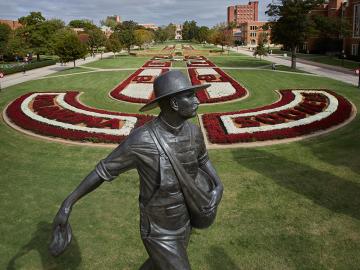
Filter News
Area of Research
- (-) Clean Energy (69)
- (-) Materials for Computing (18)
- (-) National Security (7)
- Advanced Manufacturing (7)
- Biology and Environment (37)
- Building Technologies (1)
- Computational Biology (1)
- Computational Engineering (2)
- Computer Science (4)
- Electricity and Smart Grid (1)
- Fusion and Fission (14)
- Fusion Energy (1)
- Isotopes (12)
- Materials (15)
- Mathematics (1)
- Neutron Science (16)
- Nuclear Science and Technology (1)
- Quantum information Science (3)
- Sensors and Controls (1)
- Supercomputing (21)
- Transportation Systems (1)
News Topics
- 3-D Printing/Advanced Manufacturing (25)
- Advanced Reactors (1)
- Artificial Intelligence (2)
- Big Data (3)
- Bioenergy (3)
- Biology (5)
- Biotechnology (1)
- Buildings (11)
- Chemical Sciences (5)
- Clean Water (1)
- Climate Change (4)
- Composites (5)
- Computer Science (9)
- Coronavirus (4)
- Critical Materials (3)
- Cybersecurity (3)
- Decarbonization (5)
- Energy Storage (20)
- Environment (13)
- Grid (8)
- High-Performance Computing (4)
- Isotopes (1)
- Materials (21)
- Materials Science (14)
- Mathematics (1)
- Microscopy (4)
- Nanotechnology (5)
- National Security (5)
- Net Zero (1)
- Neutron Science (6)
- Nuclear Energy (1)
- Polymers (5)
- Quantum Computing (1)
- Quantum Science (3)
- Security (2)
- Space Exploration (1)
- Statistics (1)
- Summit (1)
- Sustainable Energy (25)
- Transportation (17)
Media Contacts

Scientists at the Department of Energy’s Oak Ridge National Laboratory have developed a scalable, low-cost method to improve the joining of materials in solid-state batteries, resolving one of the big challenges in the commercial development of safe, long-lived energy storage systems.

Amy Elliott, a group leader for robotics and intelligent systems at Oak Ridge National Laboratory, has received the 2021 ASTM International Additive Manufacturing Young Professional Award for her early career research contributions

A team led by the U.S. Department of Energy’s Oak Ridge National Laboratory demonstrated the viability of a “quantum entanglement witness” capable of proving the presence of entanglement between magnetic particles, or spins, in a quantum material.

Having co-developed the power electronics behind ORNL’s compact, high-level wireless power technology for automobiles, Erdem Asa is looking to the skies to apply the same breakthrough to aviation.

ORNL and the University of Oklahoma, known as OU, recently executed a memorandum of understanding to officially recognize their partnership in pursuing shared research and development goals.

ORNL has named three researchers ORNL Corporate Fellows for their significant career accomplishments and continued leadership in their scientific fields.

Analytical chemists at ORNL have developed a rapid way to measure isotopic ratios of uranium and plutonium collected on environmental swipes, which could help International Atomic Energy Agency analysts detect the presence of undeclared nuclear

She may not wear a white coat or carry a stethoscope, but Christine Walker of ORNL spends her days diagnosing the energy health of buildings and figuring out how to improve their efficiency to achieve cost savings and reduce their carbon footprint.

Oak Ridge National Laboratory researchers have developed a novel process to manufacture extreme heat resistant carbon-carbon composites. The performance of these materials will be tested in a U.S. Navy rocket that NASA will launch this fall.

Oak Ridge National Laboratory researchers have created a technology that more realistically emulates user activities to improve cyber testbeds and ultimately prevent cyberattacks.


